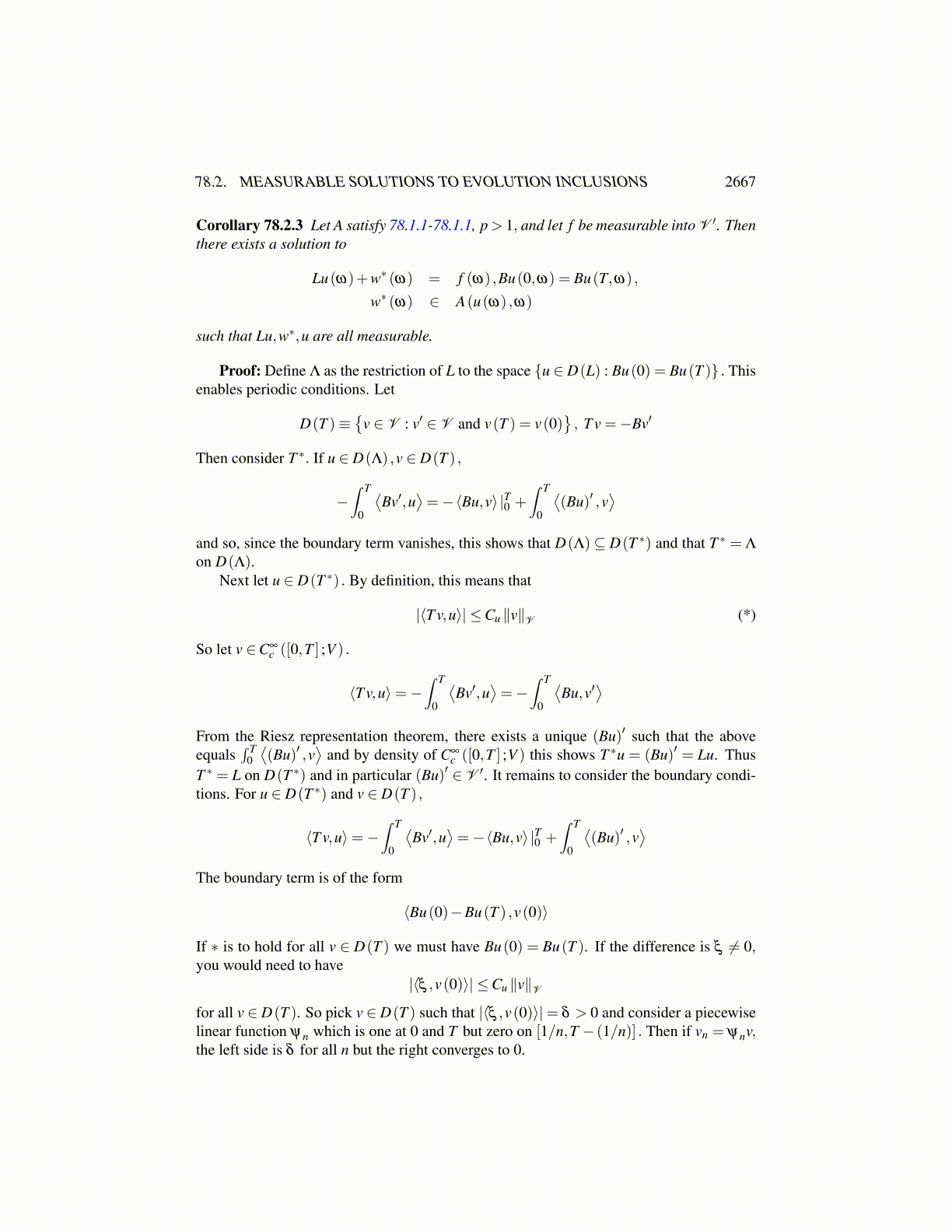
78.2. MEASURABLE SOLUTIONS TO EVOLUTION INCLUSIONS 2667
Then act on J−1Luε on both sides in the above. This yields for some C dependent on B′ aninequality of the following form.
−εC ||Luε ||2 + ||Luε ||2 +⟨w∗ε ,J
−1Luε
⟩≤⟨
f ,J−1Luε
⟩(78.2.16)
Also, acting on both sides of 78.2.14 with uε and using the formula for ⟨Ku,u⟩ ,
ε⟨Luε ,J−1Luε
⟩+
12[⟨Buε ,uε⟩(T )+ ⟨Buε ,uε⟩(0)]
+12
∫ T
0⟨B′ (t)uε (t) ,uε (t)⟩dt + ⟨w∗ε ,uε⟩V ′,V = ⟨ f ,uε⟩+ ⟨Buε (0) ,u0 (ω)⟩
= ⟨ f ,uε⟩+ ⟨Bu0 (ω) ,u0 (ω)⟩
It follows easily from the coercivity condition 78.1.6 that uε is bounded in V and conse-quently w∗ε is bounded in V ′, this from the growth estimate 78.1.1. Now from 78.2.16, italso follows that ||Luε ||V ′ is bounded for small ε . Thus
||Luε (ω)||V ′ + ||uε (ω)||V + ||w∗ε (ω)||V ′ ≤C (ω)< ∞,
C (ω) independent of small ε . By Theorem 78.1.3, there is a subsequence ε (ω)→ 0 suchthat (
Luε(ω) (ω) ,uε(ω) (ω) ,w∗ε(ω) (ω) ,Buε(ω) (ω)(0)
)→
(Lu(ω) ,u(ω) ,ξ (ω) ,Bu(ω)(0)) (78.2.17)
in V ′×V ×V ′×V ′ weakly and ω→ (Lu(ω) ,u(ω) ,ξ (ω)) is measurable into V ′×V ×V ′. It follows that Bu(ω)(0) = Bu0 (ω) because each Buε(ω) (ω)(0) = Bu0 (ω). Note thatthis also shows that Kuε ⇀ Ku in X ′. Thus, suppressing the dependence on ω, use 78.2.14to act on uε −u and obtain
ε⟨Luε −Lu,J−1Luε
⟩+ ⟨Kuε ,uε −u⟩+ ⟨w∗ε ,uε −u⟩= ⟨ f ,uε −u⟩+ ⟨g,uε −u⟩
Using monotonicity of J−1,
ε⟨Luε −Lu,J−1Lu
⟩+ ⟨Kuε ,uε −u⟩+ ⟨w∗ε ,uε −u⟩ ≤ ⟨ f ,uε −u⟩+ ⟨g,uε −u⟩
Now (Buε −Bu)(0) = 0. Therefore, uε −u ∈ D(Λ) and so
ε⟨Λ∗J−1Lu,uε −u
⟩+ ⟨Kuε ,uε −u⟩+ ⟨w∗ε ,uε −u⟩ ≤ ⟨ f ,uε −u⟩+ ⟨g,uε −u⟩
Recall that K is monotone, bounded and hemicontinuous. In fact, it is monotone and linear.Hence, K +A is pseudomonotone. Then from the above,
lim supε→0⟨Kuε +w∗ε ,uε −u⟩ ≤ 0
Now these weak convergences in 78.2.17 include the weak convergence of uε to u in X .Thus, since K +A(·,ω) is pseudomonotone as a map from X to P (X ′) , for every v ∈ X ,there exists w∗ (v) ∈ K (u)+A(u,ω) such that
lim infε→0⟨Kuε +w∗ε ,uε − v⟩ ≥ ⟨w∗ (v) ,u− v⟩